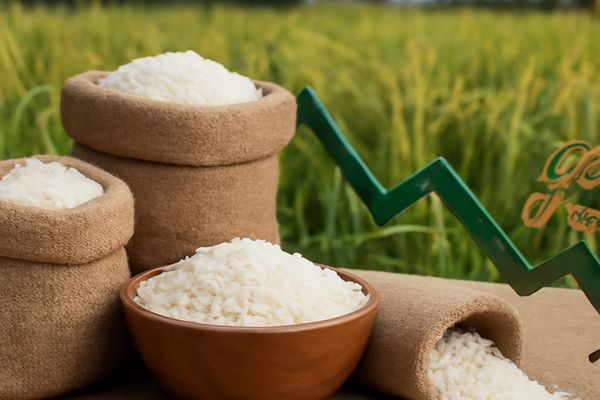The global rice market continues to grapple with persistent downward price pressure, highlighted by ongoing declines in export prices across major producers—India, Vietnam, and Pakistan. Indian export prices for 5% broken parboiled rice have reached their lowest range since late 2023, quoted between $375 and $380 per ton, with traders citing ample supplies, slow overseas demand, and cautious buying from African markets as the principal factors. This is occurring even as the world’s largest rice exporter, India, stands on the threshold of possible government policy changes following the impending general elections. The hesitance of buyers is fueled by uncertainty over adjustments to India’s export restrictions and minimum export prices (MEP).
Elsewhere, the Thai and Vietnamese rice export markets exhibit similar softness, with Vietnamese 5% broken rice prices sliding further to $590–$600 per ton and Thailand maintaining stable but elevated prices. The decrease in shipments from these regions further underscores the subdued trade environment. Conversely, Bangladesh’s domestic market remains stable, thanks to ongoing government interventions. In short, with healthy inventories global and limited new demand from key buyers, rice prices show little sign of rapid recovery until policy direction and robust demand, especially from Africa and Southeast Asia, become clearer.
Exclusive Offers on CMBroker

Rice
all golden, sella
FOB 1.00 €/kg
(from IN)

Rice
all steam, pr11
FOB 0.50 €/kg
(from IN)

Rice
al ısteam, sharbati
FOB 0.65 €/kg
(from IN)
📈 Prices
| Origin | Type | Location | FOB Price (EUR/t) | Change (w/w) | Market Sentiment |
|---|---|---|---|---|---|
| India | all golden, sella | New Delhi | 1.06 | 0.00 | Weak |
| India | all steam, pr11 | New Delhi | 0.57 | 0.00 | Stable |
| India | al ısteam, sharbati | New Delhi | 0.72 | 0.00 | Stable |
| Vietnam | long, white, 5% | Hanoi | 0.61 | +0.01 | Weak |
| Vietnam | Jasmine | Hanoi | 0.63 | +0.01 | Stable |
| Vietnam | red | Hanoi | 0.90 | +0.01 | Slightly Firm |
| Pakistan | 5% broken | Karachi | ~0.65* | -0.01* | Weak |
*Pakistan price estimated from latest USD figures and exchange rates.
🌍 Supply & Demand
- India: Ample stocks, slow export demand, subdued African/Asian buying.
- Thailand: Prices steady but shipment pace is slower, reflecting broader demand pullback.
- Vietnam: Weakened export prices attributed to declining domestic offtake and tepid foreign interest.
- Bangladesh: Stable local market, minimal imports as government subsidized sales continue.
- Pakistan: Lower export prices after fresh export order slowdown.
📊 Fundamentals
- USDA Reports: Forecasts for 2024/25 project stable or slightly increased global production, especially in Southeast Asia. End-stocks expected to remain comfortable.
- Speculative Positioning: Funds largely neutral or short rice futures, reflecting lack of bullish catalysts.
- Crop Acreage: Indian and Vietnamese government data indicate acreage planted in line with previous years, signaling no immediate supply threat.
- Inventories: Major exporters and importers report healthy carry-over stocks.
| Country | 2023/24 Production (Mt) | 2023/24 Ending Stocks (Mt) | Market Role |
|---|---|---|---|
| India | 132.0 | 36.5 | Largest exporter, stable output |
| Vietnam | 44.0 | 4.0 | Major exporter, moderate stocks |
| Thailand | 31.0 | 5.5 | Exporter, warehouse stocks rising |
| Bangladesh | 38.0 | 7.1 | Net importer, reliant on local stocks |
| PDR, Indonesia | 37.2 | 3.3 | Large consumer, stocks adequate |
⛅ Weather Outlook
- India: Monsoon rains are currently adequate in most northern and eastern rice-growing states. Some localized flooding is being monitored, but overall sowing and crop progress is good.
- Vietnam & Thailand: Seasonal rains on schedule; water management issues in parts of Mekong Delta being watched but not alarming yet.
- Pakistan: Normal seasonal temperatures with sufficient irrigation reported; no major threats to current crop.
📆 Market Drivers & Outlook
- Weak global demand remains the primary bearish driver, with buyers on the sidelines pending clarity on India’s export rules.
- Firm global inventories limit price upside despite scattered weather concerns.
- Shipment slowdowns in Thailand and Pakistan highlight the broad-based nature of demand softness.
- Currency trends and vessel charges are currently stable and not influencing FOB offers materially.
- Any fresh demand from Africa or Southeast Asia—or significant policy changes by India—could shift sentiment.
💡 Trading Recommendations
- If holding inventory, focus on offloading at present prices—downside risk remains in the absence of demand uptick.
- Buyers should maintain a wait-and-see approach, monitor for policy changes from India for opportunity windows.
- Watch for weather news from Southeast Asia, though risks currently appear moderate.
- Risk hedging is advised given ongoing uncertainty over India’s export regime post-election.
🔮 3-Day Regional Price Forecast
| Region | Current Price (USD/t) | Forecast Range | Outlook |
|---|---|---|---|
| India (5% broken) | 375–380 | 375–382 | Soft/Stable |
| Vietnam (5% broken) | 590–600 | 585–600 | Weak |
| Thailand (5% broken) | 607–615 | 605–615 | Steady |
| Pakistan (5% broken) | 630–640 | 627–637 | Weak |


